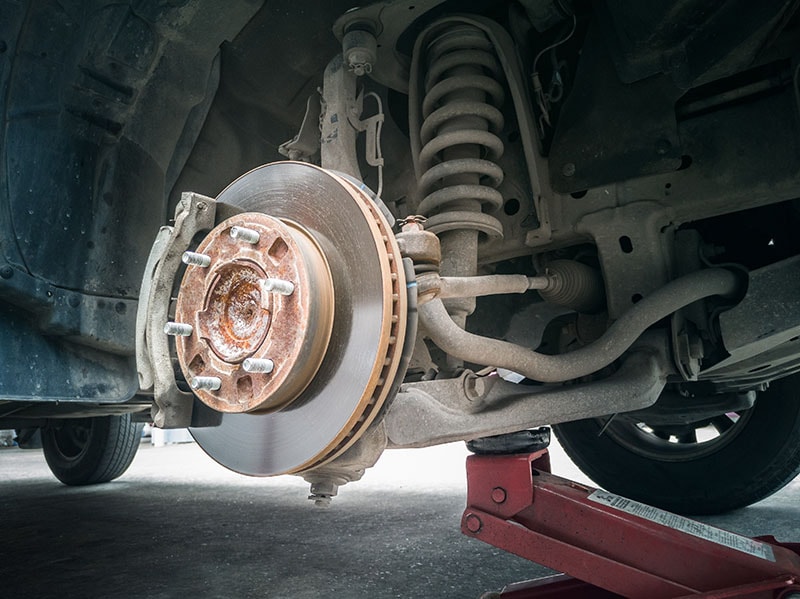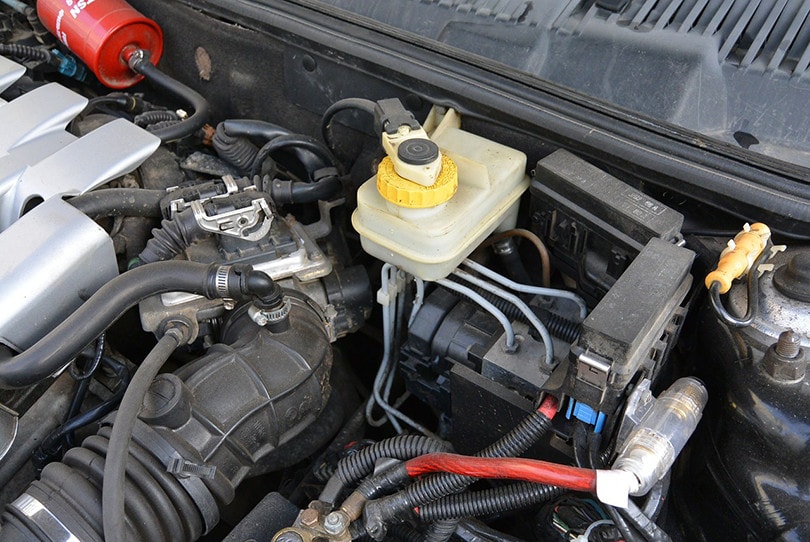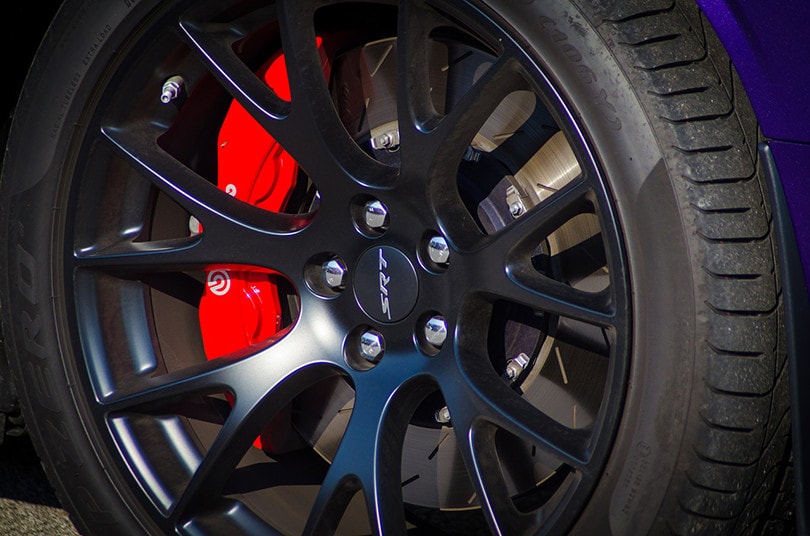What Are Anti-Lock Brakes? Pros, Cons & FAQ
-
Jeff Weishaupt
- Last updated:

There’s no doubt that the first-ever cars were no paragons of safety and reliance. Instead, they were simply a glimpse into what we have today: a nearly foolproof machine with endless safety features, one of them being the anti-lock braking system.
The anti-lock braking system allows you to prevent your car from skidding without having to pump the brake pedals. But, of course, all modern cars include this feature. It allows the car to maintain tractive contact with the surface and the driver to retain control over the car.
We all know that our cars, buses, and trucks have anti-lock brakes, but only a few know how they really work. If you’re here to learn more about this modern safety feature, you’re at the right place. Keep reading to understand anti-lock brakes, their types, pros, and cons.
 How Do Anti-Lock Brakes Work?
How Do Anti-Lock Brakes Work?

Also known as the anti-lock controller brake, the anti-lock braking system (ABS) has three components: speed sensors, an electronic control unit, and hydraulic valves. The electronic control unit oversees the wheels’ rotational speed and acts accordingly.
For example, if a wheel is slower than the vehicle, it can lead to an impending wheel lock. So, the control unit activates the hydraulic valves to reduce the brakes’ hydraulic pressure at the specific wheel. This results in a lower braking force and faster wheel speed.
On the other hand, the control unit may detect a wheel going faster than the vehicle. In this case, it will increase the hydraulic pressure and braking force, causing the wheel to slow down. This process is ongoing as the vehicle is in use, and the driver can rely on brake pedal pulsation to detect it.
When the vehicle turns, the electronic control unit detects the wheel’s speed below a certain threshold. That is crucial as the two wheels near the curve turn slower than the other two wheels, which is why all roadgoing vehicles use differentials.
However, if the system detects any failure, it flashes a warning light and disables the anti-lock brakes until the fault is fixed. Modern versions of the anti-lock braking system apply individual brake pressure to each wheel. They do so with the help of their dedicated microcontroller and hub-mounted sensors.
Recent Changes
The anti-lock braking system has recently evolved into an electronic stability control system. This system relies on two additional sensors for operation: a gyroscopic sensor and a steering wheel angle sensor.
When the steering wheel sensor contradicts the car’s intended direction, the system will brake all necessary wheels (up to three), allowing the car to take the required direction. The steering wheel sensor also aids the Cornering Brake Control, telling the vehicle how much each wheel should brake.
Components
The anti-locking braking system consists of a controller, a pump, valves, and wheel speed sensors. Each component has a crucial purpose.
The controller is notified whenever a wheel loses traction. Then, it limits the brake force and activates the valves if necessary. These valves are in each brake line, having three positions in most modern systems.
The first position has an open valve, which passes the master cylinder’s pressure to the brake. Meanwhile, the second position has the brake line blocked by the valve. This isolates it from the cylinder and prevents the pressure from rising. Finally, the third position allows the valve to release the brake’s pressure. If the valve system faces issues, it’s most likely due to clogged valves. They can prevent the system from adjusting the hydraulic pressure accordingly.
The anti-locking braking system’s pump restores hydraulic pressure after the valves release it. The controller notifies wheel slips, releasing the valve and allowing the pump to restore pressure to the braking system.
Then, the controller adjusts the pump’s status to guarantee the required pressure and prevent the car from slipping. Finally, the speed sensors, also known as encoders, determine the wheel’s speed.
They rely on a Hall effect sensor and magnet to generate signals. Meanwhile, the wheel’s rotation creates a magnetic field around the speed sensors. This magnetic field supplies the sensors with voltage, which can cause the sensor to relay inaccurate reports at slow speeds.

Effectiveness
According to a 2004 study by Monash University Accident Research Centre, an anti-lock braking system reduces the risk of car crashes by 18%. It also increases the risk of run-off-road crashes by 35%.
Additionally, cars with anti-lock braking systems may benefit from better braking distances. This is much likelier on high-friction surfaces like concrete or bitumen than on those without ABS. In most situations, even experienced drivers would find it challenging to maintain brake control without an ABS.
Overall, anti-lock braking systems reduce the severity of impact alongside the chances of crashes. However, drivers without ABS must rely on pressing the brake pedals firmly and steer appropriately in a full-braking emergency.
In such a situation, anti-lock brakes would help reduce skidding and an eventual loss of control over the vehicle. In addition, these systems guarantee an increase in braking distances even in deep snow, sand, or gravel. The locked wheel may dig into such surfaces and stop the car even faster, which the ABS may prevent. Anti-lock brake calibrations may slow down the cycling and allow the wheels to repeatedly lock and unlock to prevent such issues.
Additionally, car manufacturers often include off-road buttons in the vehicle. This allows drivers to turn off the ABS function as necessary. Its primary benefit is to allow drivers to retain control over the vehicle and prevent skidding. Meanwhile, they may still lose control on soft or slippery surfaces.
On gravel or ice sheets, the car may even suffer from multiple locked wheels simultaneously. This may defeat the anti-lock braking system entirely since it relies on the monitoring of all four wheels and detecting each wheel’s fault individually.
However, drivers can benefit from anti-lock braking systems since they won’t have to learn threshold braking. Lastly, a 1999 National Highway Traffic Safety Administration (NHTSA) study details that ABS can increase brake distances on loose gravel by 27%.
What Are the Different Types of Anti-Lock Brakes?
Four-Channel
The types of anti-lock brakes depend on the number of sensors and channels. For example, the four-channel, four-sensor anti-lock braking system has a dedicated valve and sensor for each wheel. This setup allows the controller to maintain maximum braking force for each wheel.
Three-Channel
Other than that, the three-channel, four-sensor anti-lock braking system has dedicated sensors for each wheel and dedicated valves for the front wheels. Meanwhile, the rear wheels share one valve, which is an aspect found in older anti-lock braking systems.
The three-channel, three-sensor ABS has dedicated valves and sensors for the front wheels. Meanwhile, the rear wheels share one valve and sensor. This system is typically found in pickup trucks and guarantees complete control of the front wheels.
As a result, they’re able to retain maximum braking force, while the rear wheels will suffer some locking before the system is activated. This may cause at least one of the wheels to lock and reduce brake effectiveness.

Two-Channel
Meanwhile, the two-channel, four-sensor anti-braking system has dedicated sensors for each wheel. It also has one valve for the front wheels and one valve for the rear wheels. If any sensor detects a fault, the control module pulses both valves.
One-Channel
Finally, the one-channel, one-sensor anti-lock braking system relies on a single valve to control the rear wheels. A single sensor is also placed on the rear axle. The system monitors the rear wheels as one, locking them up slightly before maintaining the pressure.
This type of anti-lock brake leaves room for wheel locking and reduced brake effectiveness.

Where Are Anti-Lock Brakes Used?
The anti-lock braking system is used in different variations and control algorithms. For example, the controller continually oversees the speed sensors to detect unusual decelerations. As a result, wheels suffer from drastic deceleration right before locking up.
If this aspect is neglected, the wheel will stop way before the car. In ideal conditions, most cars stop within 2–4 seconds, while the wheel can stop within 1 second. But, of course, the controller is aware that the car can’t stop within a second, so it reduces the brake pressure to promote acceleration.
Then, it will increase the brake pressure to decelerate the wheel again, doing this so rapidly that the wheel barely changes speed. As a result, the wheel and the car slow down at the same rate, while the brakes keep the wheels very near to the locking point.
While this process maintains maximum braking power, it also means drivers don’t have to manually pump the brakes. Instead, they can steer while panic braking and feel the brake pedal pulsing to determine whether ABS is actuated.
Advantages of Anti-Lock Brakes
Of course, the anti-locking braking system has endless benefits for the modern car. First, it’s beneficial while stopping your car on ice, preventing lock-ups, skidding, and slips. In fact, they’ve been proven to save lives in various situations as they allow the driver to retain control over the vehicle.
Additionally, the right anti-locking braking system has helped lower insurance costs. This tried and tested safety feature has an undeniable track record of effectiveness. That is why you may find insurers willing to offer discounts if your car has an ABS.
Of course, anti-lock braking systems also contribute to a higher resale value on your vehicle. But this is only possible for older models of cars that typically don’t come with ABS. Since most modern cars feature ABS technology, you may not be able to score a higher resale value.
Finally, anti-locking brake systems allow for better traction control. In fact, it has many similarities with a traction control system, as it allows the wheel to have better friction on the road. This way, manufacturers can easily install both features in a vehicle.

Disadvantages of Anti-Lock Brakes
There’s no doubt that anti-locking brake systems provide adequate safety in most situations. Additionally, they may compel insurers to lower their rates and allow your wheels to have better traction. However, they still have some disadvantages.
For example, an anti-lock braking system may have inconsistent stop times. Their purpose is to guarantee better braking in slippery conditions. But some drivers are unsatisfied with the stopping distances in regular conditions.
Anti-lock braking systems may lengthen the stopping times due to errors in the system or the driver not braking at the same speed. This also leads to a clunking noise coming from the braking system.
Additionally, anti-lock braking systems can be somewhat pricey to maintain. That is because each wheel sensor may cost hundreds of dollars to repair in case of recalibration or other problems. As a result, many drivers deny the ABS option in their cars.
Lastly, anti-locking brake systems may be somewhat delicate since it’s relatively easy to cause issues with the brakes. For example, disorienting the ABS can cause the vehicle to shudder, brake worse, or make loud noises due to compensating brake sensors.
 Frequently Asked Questions (FAQs)
Frequently Asked Questions (FAQs)
Are Anti-Lock Brakes Safe?
According to a study by Insurance Institute for Highway Safety (IIHS), motorcycles without ABS are 37% more vulnerable to fatal crashes. Additionally, a study by the Swedish Road Administration details that 48% of motorcycle accidents can be avoided with an ABS.
When Are Anti-Lock Brakes Most Effective?
The anti-lock braking system is most effective on solid and dry road surfaces. Here, it would help the driver brake much faster while still retaining control over their car. In addition, since this system repeatedly releases the brake for small intervals, it can increase the car’s overall stopping distances.
On the other hand, anti-lock brakes lose some effectiveness on slippery surfaces, such as ice and snow.

What Does the ABS Warning Light Mean?
The ABS warning light flashes once the controller finds a fault in the anti-lock braking system. In such cases, it’s best to check your car’s handbook to figure out what the warning light means. For example, it could mean that the anti-lock braking system isn’t activated.
Of course, this directly affects the operation of other systems in your cars. That includes the traction control system or stability control system. Therefore, it’s vital to get your ABS checked if your car has these systems.
 Conclusion
Conclusion
Despite their vulnerabilities, anti-locking brakes are any vehicle’s most critical safety features. They’re especially helpful in situations where the car may skid or slide unsafely. Now that you know about the effectiveness and importance of anti-lock braking systems, you can ensure that your next car has a modern ABS.
Featured Image Credit: Chettaprinn P, Shutterstock
Contents
 How Do Anti-Lock Brakes Work?
How Do Anti-Lock Brakes Work? Frequently Asked Questions (FAQs)
Frequently Asked Questions (FAQs)